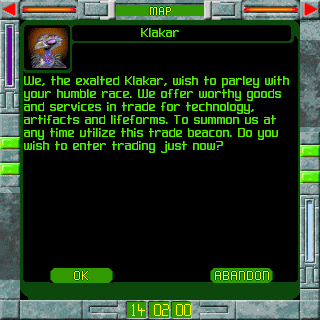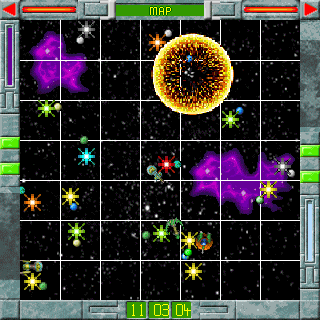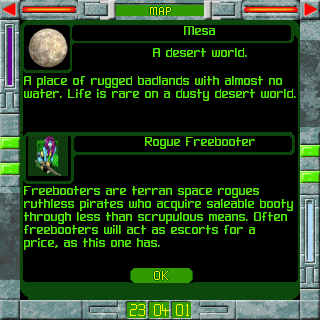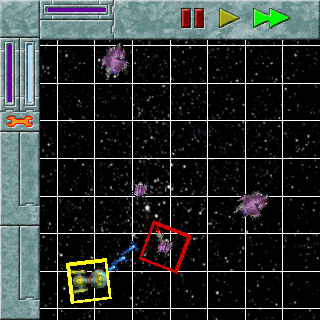
|
|
|
| Mon Nov 20, 2006 - 11:55 PM EST - By Mike Overbo | |
|
|
|
|
I can't tell you how many times I've had to decide between going up into space and having strange adventures or just playing a simulation of it on my phone. Here and there, I find myself strapped for cash and perhaps unable to $20 million to pay the Russian Space Program to launch me up. Being naturally budget conscious, I sometimes choose the phone option. How good of a simulation of strange adventure in infinite space is Strange Adventures in Infinite Space?
Strange Adventures in Infinite Space is published and ported by Astraware, one of the larger game publishing companies in the market. They're responsible for porting and releasing games like Bejeweled, Bejeweled 2, Astraware Sudoku, and and have a vast catalog of games for various handheld platforms.
It costs $14.95, and requires Palm OS 5 and a 320x320 screen to play. Though there is a version for PocketPC, It is not compatible with the 700w, and their website doesn't explicitly list compatibility with the 700wx or 750v.
The game itself was licensed from and written by indie games designer Digital Eel. They have written a sequel named Weird Worlds: Return to Infinite Space, though the sequel is not yet available on mobile platforms.
First, you select the weapons to be equipped on your ship, how much of the screen should be nebulae, and how many enemies you'll be fighting at once. The game then spells out the story with you, our hero, as a new employee of Lextor Mucron (notorious robot smuggler, moonshine baron, and wise guy), who wants you to break the self-imposed isolation of the Glory system in a ship. He's graciously equipped this converted military wessel which you Kiptin. You are prompted to leave and go grab some alien treasures, lifeforms, and equipment, and try to be back in 10 years. Your ship starts out with some, well, pretty cruddy equipment, and you find yourself plopped down in the middle of a star chart with various stars of different colors, nebulae, and the 10 year deadline to beat.
You can fly to a different star system by tapping on a star. Depending on your equipment, you might want to scan the system before you arrive. Depending on your sensor array, you may know that you're in for a fight just by the fact that your sensors have detected hostile aliens. If you try and fly through the purple nebula, your ship moves very slowly unless you have an upgraded nebular drive. There are upgrades available that can make your ship better in many regards. Initially, the easiest way to upgrade is to trade with the Klakar.
Your equipment might not be good, but it's generally enough to get you to the Klakar, who are generally waiting in a nearby yellow star system, and they are always eager to trade with you. They give you a Klakar Beacon, which you can use to summon them at any time (including during combat).

They have no concept of value, which is both good and bad. They would gladly trade a Graviton Explosion Drive for your primitive Chemical Rocket Thrusters. Until you play the game quite a bit, you won't know what many items are worth. It helps to pay close attention to the adjectives and adverbs used in the description of the items, or to compare two items by retreating from combat and switching them. Some items, such as missiles and lightspeed drives, have numbers associated with them to help you gauge their worth. The good news is that you can always trade back.
There are various baubles, treasures, lifeforms, chance encounters, hostile alien ships, and weapons that you pick up as you visit planets. One of the nice touches of the treasures is that it seems they wove a story behind the items. There are or were apparently important people that left baubles and doodads behind, and the game kind of teases you with them, but doesn't really go beyond teasing. There doesn't seem to be any real mystery behind it, which I think is unfortunate. Since most of the baubles have the same art, it would merely require more text to have more treasure and more storyline. I've played this game hundreds of times, and each time I think it's out of surprises, I encounter something I haven't seen before.

If there is a convoy of hostile alien ships waiting for you at the planet you're visiting, you'll have to destroy them before you can get the planetary booty. Sometimes, it's not pleasant. Every once in a while, you're ransacked by thieves or saboteurs. Sometimes the star explodes, which really is never pleasant for anyone. Sometimes only your ship explodes, sometimes you only lose a component of your spaceship. It might be odd to consider this as booty, but sometimes that's what's behind door #2.

You can pick up allies in your journey, and some allies will even join your cause for free. Most are mercenary, however, and will want some sort of recompense for aiding you. You tell ships what to do in the combat screen by clicking on their ship and dragging where you want them to go or clicking on the enemy you want them to attack. Sometimes they attack intelligently, sometimes they don't. Left to its own devices, your ship will often attack in fits and spurts. There is no way to manually aim guns on your ship, it's all done for you. The addition of a ship computer can help your ship attack more intelligently. Indeed, a ship computer is almost necessary if you want to use beam weapons like lasers or ray guns. Without one, you're often stuck watching your ship flail around spastically. There will unfortunately be times in combat when it is best to walk away from the screen for a few minutes while your ship attacks on autopilot, or bank away and re-attack. You'll be able to recognize these times by the fact that your ship is running circles around the enemy ship and looks like it's having a panic attack, seizure, or similarly unfortunate medical episode. Score another one for realism.

Strange Adventures in Infinite Space packs no small amount of ambience for a game of its size. The music is very well suited for the genre, and I can play the game comfortably with it on or off. You can disable music or sound effects, or arrange their volume individually via a slider.
When you pause the game, it shows a screen reminiscent of MST3k, though it's readily apparent that who you see is not Joel, Tom Servo, or Crow. Your ship looks a lot like the Enterprise, and there's a fair amount of camp to be had. The game and its premise is a lot like Star Trek, but thankfully without any of the morality or the prime directive.
The visuals and text are very small. This doesn't really matter a whole lot, but it's frankly the difference between giving this game 4/5 and 5/5. Most of their graphics are 40 x 41 pixels*, but when a screen is 320 x 320, I feel a bit cheated every time I see black margins around the pictures. I wish they were able to cram a bit more, or perhaps use some sort of scrolling so the game wasn't quite so confined, or rearrange the borders to give you some more real estate.

All in all, space opera and science fiction fans are the target for this game, and it's right on the mark. If you like a bit of camp humor, this game will be right up your alley as well. I spent a lot of time playing this game as I avoided writing the review for it, and it's a fair reproduction of other campy adventures like the StarCon series and any game that mocks Star Trek while it steals Star Trek's ideas.
|
|
||||||||||||||||||||
|
Copyright 1999-2016 TreoCentral. All rights reserved :
Terms of Use : Privacy Policy
TREO and TreoCentral are trademarks or registered trademarks of palm, Inc. in the United States and other countries;
the TreoCentral mark and domain name are used under license from palm, Inc.
The views expressed on this website are solely those of the proprietor, or
contributors to the site, and do not necessarily reflect the views of palm, Inc.
Read Merciful by Casey Adolfsson